 Famous for experimenting on himself with a brew of H. pylori, Nobel Laureate Professor Barry Marshall might not be the person parents want their young Einstein copying at home.
Famous for experimenting on himself with a brew of H. pylori, Nobel Laureate Professor Barry Marshall might not be the person parents want their young Einstein copying at home.
Professor Marshall also admits to a penchant for things that go boom – possibly due to growing up in Kalgoorlie where ‘there were things much bigger than firecrackers on Guy Fawkes night’.
However he promises he’s reined in the science experiments he recommends in his new children’s book How to Win a Nobel Prize.
Professor Marshall told the limbic the concept for the book grew from a chat two years ago with a friend’s then eight-year-old daughter Mary.
“I said I was thinking about doing a kid’s book about Nobel Prize winners and Mary said she loves doing scientific experiments and she’s got a few books and does these at home with her Mum and Dad. So we did a bit of brainstorming.”
“I had to pick out my favourite Nobel Laureates and then try to put the story of their discovery in a way that kids would like to read it and have something practical around each story that kids could do.”
Professor Marshall said he can largely be the ideas man in his research and other projects now so the book was co-written by Lorna Hendry and illustrated by Bernard Caleo.
His own story, shared with colleague Robin Warren, just made the cut.
“We were just interested in science and ‘Hey, how could a bacteria live in acid? What’s going on here?’ And then that curiosity leads to a major breakthrough – something that nobody could ever have imagined and that’s the theme I suppose with all these different discoveries.”
“90% inspiration and 10% perspiration is the best way to win Nobel Prizes I think.”
The book includes ‘probably everybody’s favourite’ Albert Einstein, DNA’s Crick, Watson and Wilkins, father of penicillin Howard Florey, and inventor of radio Guglielmo Marconi.
“The story is like a dream with Mary and I walking around opening doors and going into each scientist’s lab, seeing what was going on and having a chat with them.”
And for each Nobel Prize story, there is a practical experiment which 9-12 year olds should be able to do at home.
“They can read and write, have some biology and practical skills and have a bit of an idea about their mother’s pantry – things that fizz and acids and bases. Cooking is a complicated version of chemistry,” he said.
“I think it’s going to be a popular book. I can tell you that if I was travelling and saw this in an airport book shop as I was waiting for my plane, I would buy it in five seconds and give it to one of my grandchildren.”
Women in STEM
As well as boasting a young female protagonist, the book also had no trouble shortlisting stories about women who won Nobel Prizes.
“Marie Curie won the Nobel Prize twice. She’s famous because she won one in Physics, shared with her husband, and one in Chemistry. As far as world records, she is right up there. She was an interesting person who battled adversity to a certain extent,” he said.
Less well-known in Australia is Dr Tu Youyou from China who was awarded a Nobel Prize for her work leading to an anti-malarial treatment.
“About 20 to 25% of Nobel Prize winners are women but if you look at the last 10 years, it’s probably moving up. Women have probably got more options than they’ve ever had and I don’t see that in the sciences there is a glass ceiling.”
The book will be available on 2 April with part of the proceeds supporting the Marshall Centre for Infectious Diseases Research and Training at the University of Western Australia.